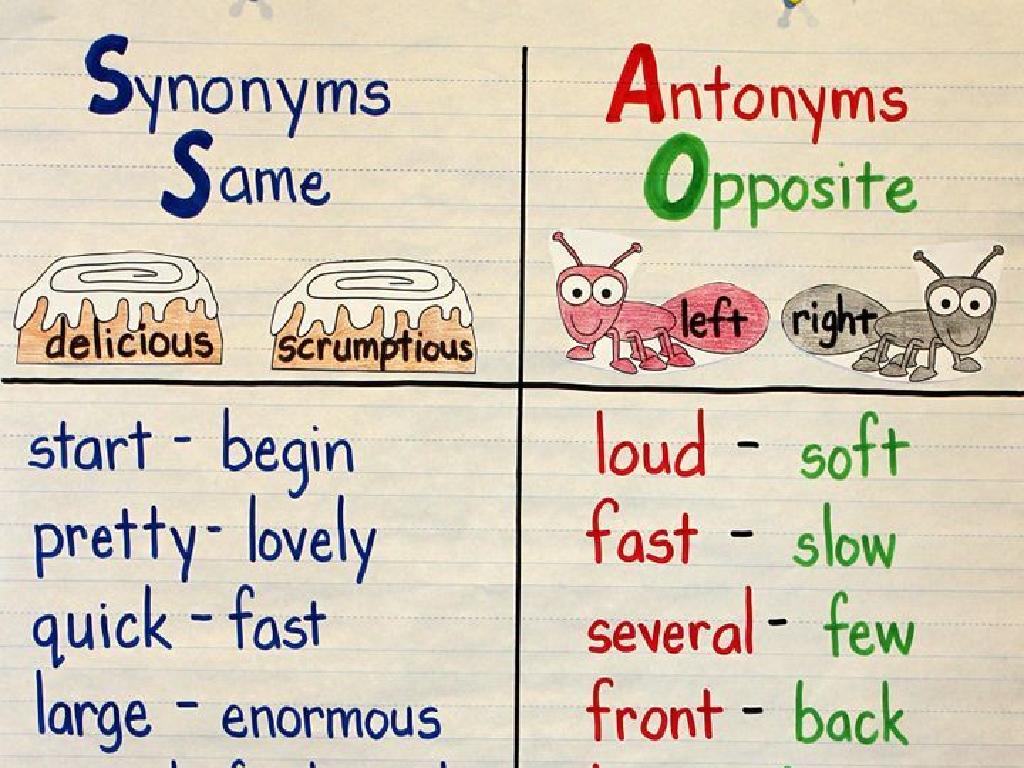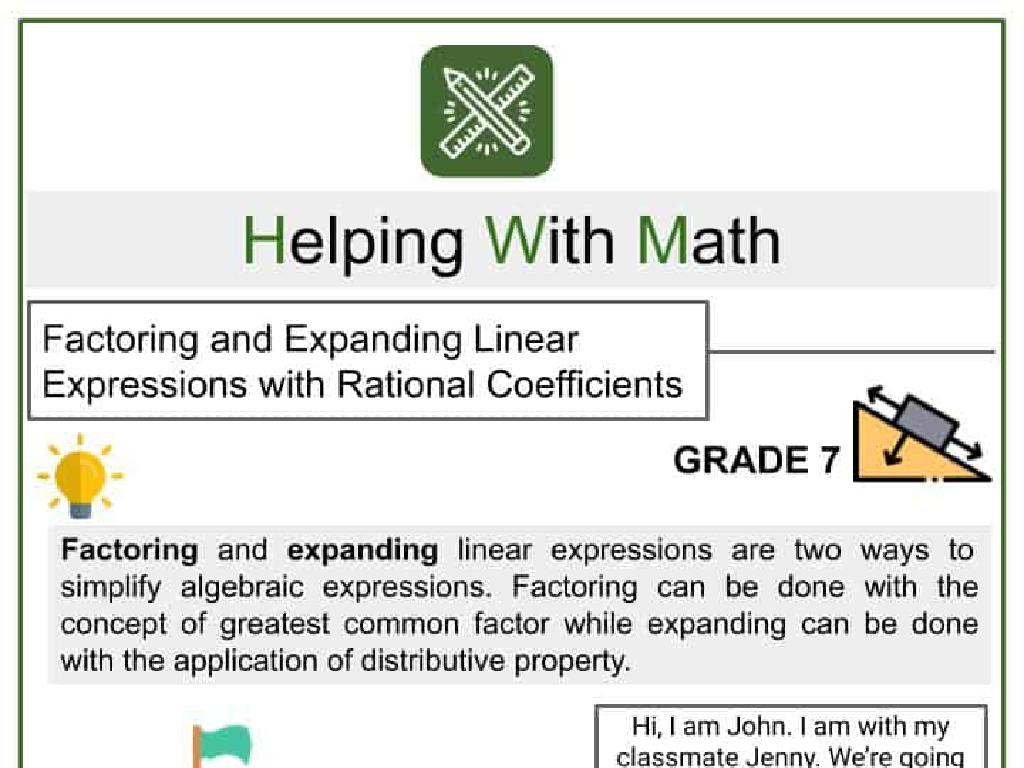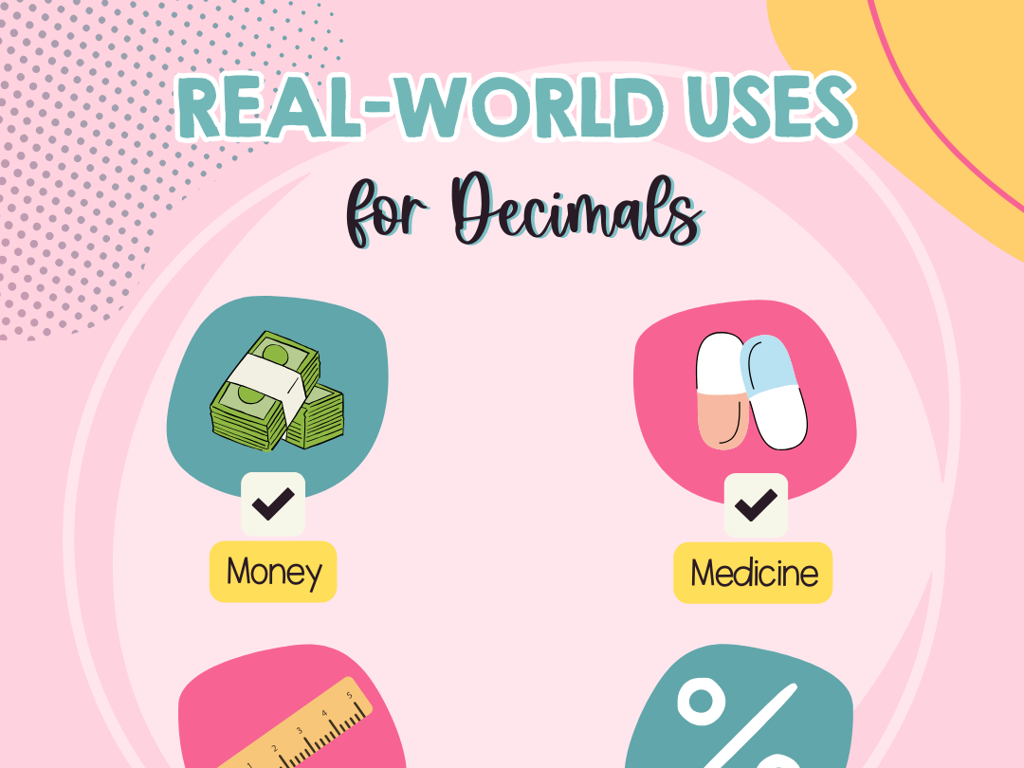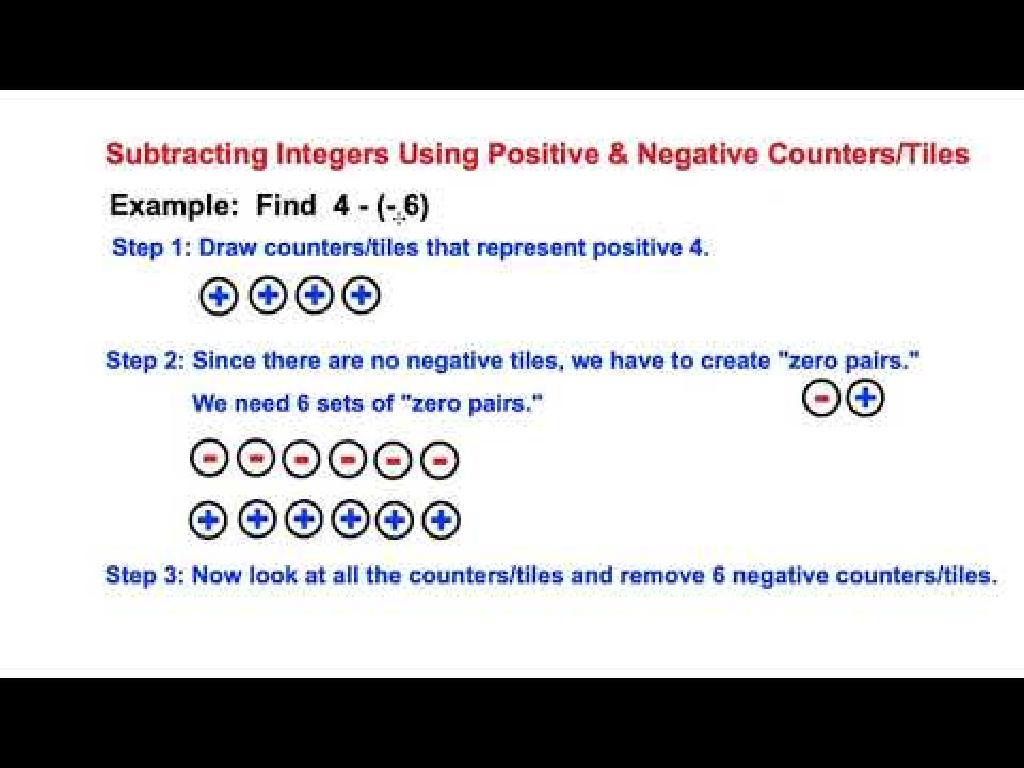Scale Drawings: Word Problems
Subject: Math
Grade: Seventh grade
Topic: Scale Drawings
Please LOG IN to download the presentation. Access is available to registered users only.
View More Content
Introduction to Scale Drawings
– Understanding scale drawings
– A scale drawing represents an object larger or smaller than its real size.
– Scale drawings in real life
– Architects use scale drawings to design buildings; city planners use them to map out cities.
– Relation to maps and models
– Maps are scale drawings, showing vast areas in a smaller space; models are scaled-down versions of objects.
– Significance of scales
|
This slide introduces the concept of scale drawings, which are representations that maintain the proportions of the depicted object but alter its size. It’s crucial for students to grasp that scale drawings are everywhere in our daily lives, from the blueprints of a house to the layout of a city. Emphasize the practicality of scale drawings in various professions and their importance in planning and design. Discuss how maps are essentially scale drawings of geographical areas, and models are scaled versions of objects, often used in education and design. Encourage students to think of examples of scale drawings they’ve encountered. This will set the foundation for solving word problems involving scale drawings.
Understanding Scales in Scale Drawings
– Define a scale in drawings
– A scale is a proportion used in determining the relationship between the actual object and its representation.
– Explore the ratio in scales
– The ratio represents how many units on the drawing are equivalent to the real-world measurements.
– Example: 1 inch to 1 foot
– This means that 1 inch on the drawing equals 1 foot in real life.
– Example: 1 cm to 1 meter
– Here, 1 centimeter on the drawing corresponds to 1 meter in reality.
|
This slide introduces the concept of scales and how they are used in scale drawings. A scale is a ratio that helps us represent large objects on paper in a smaller, more manageable size. It’s crucial to understand that the scale tells us how measurements on the drawing relate to the object’s actual size. For example, a scale of 1 inch to 1 foot means that for every inch on the drawing, the actual object is one foot in that dimension. Similarly, a scale of 1 cm to 1 meter means each centimeter on the drawing represents one meter of the actual object. Encourage students to think of other examples and how scales might be used in various professions, such as architecture or map-making.
Creating a Scale Drawing
– Steps for scale drawings
– Measure the object, decide on the scale, draw the grid, transfer measurements, outline, and detail.
– Choosing an appropriate scale
– Scale should simplify real measurements while maintaining proportions.
– Tools required for drawing
– Ruler, graph paper, pencil, and eraser are essential.
– Class activity: Create a scale drawing
– Each student will create a scale drawing of a classroom object.
|
This slide introduces students to the process of creating scale drawings, an important skill in both math and real-world applications. Start by explaining the steps to create a scale drawing, emphasizing the importance of accurate measurements and proportionality. Discuss how to choose a scale that simplifies measurements while still representing the object accurately. List the basic tools needed and ensure students have access to these. For the class activity, provide a variety of classroom objects for students to choose from and create their own scale drawings. This hands-on activity will help solidify their understanding of scale drawings. Provide guidance and support as they work through the steps.
Scale Drawing Word Problems
– Read and understand the problem
– Identify the scale and dimensions
– Scale is the ratio of drawing to actual size. Calculate dimensions using this.
– Solve a sample problem together
– We’ll work through an example as a class to demonstrate the process.
– Discuss the solution process
– Understanding each step is crucial for mastering scale drawings.
|
This slide introduces students to solving word problems involving scale drawings, a key skill in understanding real-world applications of math. Start by guiding students on how to carefully read and comprehend what the problem is asking. Emphasize the importance of identifying the scale given in the problem, as it is essential for calculating the actual dimensions. Work through a sample problem as a class to illustrate the step-by-step process, ensuring to involve students in each stage of the solution. Encourage them to ask questions and discuss their thoughts on the method used. This interactive approach helps solidify their understanding of scale drawings in a practical context.
Scale Drawings: Solving Practice Problems
– Work on practice problems together
– Discuss problem-solving strategies
– How to approach a problem? Break it down into steps.
– Engage in peer discussions
– Explain your reasoning to a classmate, and listen to theirs.
– Share solutions and methods
– Compare different approaches to the same problem.
|
This slide is focused on interactive problem-solving for scale drawing word problems. Start by working through a few practice problems as a class to demonstrate common strategies such as identifying the scale factor, setting up proportions, and using units of measure consistently. Encourage students to discuss their strategies with peers, fostering a collaborative learning environment. Facilitate peer discussions by pairing students or forming small groups, and prompt them to explain their thought processes. Conclude by sharing different solutions to the same problem, highlighting the value of diverse methods and reinforcing the learning objectives. Provide guidance and support throughout the activity, ensuring that each student is engaged and understands the concepts.
Class Activity: Crafting Scale Drawings
– Select an object or space for your drawing
– Decide on a suitable scale
– The scale could be 1 cm = 1 m for large objects or 1 cm = 1 inch for smaller items
– Draw your model using rulers and graph paper
– Ensure measurements are precise for a true-to-scale representation
– Reflect on the process and accuracy
|
This activity is designed to give students hands-on experience with scale drawings. They should choose an object or space that interests them, which will make the activity more engaging. When determining the scale, guide them to consider the size of the original object and the size of the paper they will be using. Provide rulers and graph paper, and instruct them on how to use the scale to measure and draw accurately. After completing the drawings, have students share their work with the class and discuss any challenges they faced and how they overcame them. Possible variations of the activity could include drawing a classroom layout, a dream bedroom, or a playground design.
Scale Drawings: Review and Q&A
– Recap key scale drawing concepts
– Review ratios, scale factors, and real-world representation.
– Open floor for student questions
– Work through extra examples
– Demonstrate with different scale problems.
– Summarize today’s key takeaways
– Ensure understanding of scale drawing applications.
|
This slide aims to consolidate the students’ knowledge of scale drawings by reviewing the key concepts covered in the lesson, such as understanding ratios and scale factors, and how they apply to creating accurate representations of real-world objects. Encourage students to ask questions to clarify any doubts. Be prepared to provide additional examples to reinforce learning, and use this opportunity to assess comprehension. Summarize the lesson by highlighting the importance of scale drawings in various fields like architecture, engineering, and cartography. This will help students appreciate the practical applications of what they’ve learned.
Homework: Scale Drawing Word Problems
– Complete scale drawing problems
– Draw a scale model of your bedroom
– Use a ruler to measure and a pencil to sketch your room accurately.
– Reflect on methods used
– Think about the steps you took to create your drawing.
– Discuss any challenges faced
– Were there any obstacles? How did you overcome them?
|
This homework assignment is designed to reinforce students’ understanding of scale drawings through practical application. Students will solve word problems to gain familiarity with the concept and then create a scale drawing of their own bedroom, which will help them connect the mathematical concept to real life. Encourage students to measure their room dimensions carefully and decide on an appropriate scale. They should document their process and be ready to discuss the strategies they used and any difficulties they encountered. This will prepare them for a class discussion where they can learn from each other’s experiences and problem-solving approaches.






